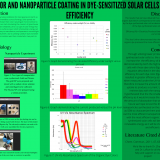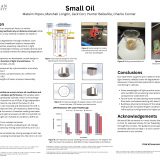
Varying Dye Color and Nanoparticle Coating in Dye-Sensitized Solar Cells for the Highest Efficiency Tia Fidaleo, Jackson Goldberg, Ramsey Elshiwick, Elif Narbay
May 11, 2021
As the climate crisis emergency gains a new sense of urgency with only less than 10 years remaining until the damage becomes irreversible, the need for integrating renewable energy sources into our society becomes even more pressing. Solar panels are expensive but if we can increase their efficiency and lower their cost it would give more incentive to make the shift away from fossil fuels and in doing so we can start eliminating the creators of greenhouse gases. Our proposed solution is Dye-Synthesized Solar Cells(DSSC); this is a type of solar energy that utilizes nanoparticle coatings in order to increases the surface area in which photovoltaic energy can be captured from the sun. The method is low-cost, easy to manufacture, and operates in normal light conditions, but this method does result in high toxicity levels due to utilizing rubidium dye and lower efficiency levels comparatively to other solar cells. In order to eliminate these issues this project investigated which organic dye color (utilizing anthocyanin, such as cabbages or blueberries, to eliminate toxicity) would create the most efficient solar cell as well as which type of nanoparticle coating (i,e. gold, titania and graphene) would increase the efficiency of the solar cells. The results obtained demonstrated that the lower the pH of the organic dye (which corresponds to the colors red and pink) the higher the current produced by the dye-synthesized solar cell and therefore a greater calculated efficiency percentage. The red and pink organic dyes resulted in greater efficiency as they obtain the greatest absorbance when measured under the UV-Vis Absorbance Spectrum and therefore increase the amount of UV light that the synthesized cell can uptake to produce a current. Unfortunately, we ran out of time to retrieve data with the nanoparticle experiment, however, we hypothesized that the the smaller sized nanoparticles would increase efficiency as it would increase the amount of surface area and therefore the amount of absorption that would occur would also increase. In the future we hope to test this theory by both testing the different nanoparticles synthesized on the solar cell as well as using imaging such as SEM to characterize them and determine their size. If we can figure out the most efficient nanoparticle coating and use them in conjunction with the most efficient organic dye colors (pink and red) then dye-synthesized solar cells will become a more attractive option for renewable energy as it will be cheaper, more environmentally friendly and efficient source of energy.
Varying Dye Color and Nanoparticle Coating in Dye-Sensitized Solar Cells Poster


